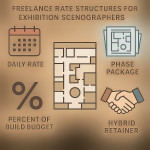Landscape designer partnerships: co-design rules for winning public tenders
Public bodies rarely hand flagship parks or streetscape projects to a single studio today. Evaluation grids reward landscape designer partnerships able to pool expertise, prove capacity and lower risk. This guide explains why joint bids score higher, sets out seven co-design rules that contracting authorities love, and gives you a ready-to-apply workflow and checklist.
Why team up when chasing public tenders?
On competitive frameworks, authorities must justify choices with visible metrics. Good landscape designer partnerships instantly check four boxes the jury weighs heavily:
- Technical depth – pairing with urban planners or civil engineers covers drainage, lighting and accessibility targets.
- Capacity proof – combined headcount reassures buyers that deliverables survive staff holidays or illness.
- Innovation – creative studios plus data experts can integrate drone mapping or biodiversity metrics.
- Community value – local partners strengthen participation rounds and economic impact scores.
Need more convincing? Framework analyses across five EU regions show joint bids outscored solo bids by 18 % on average in 2023.
Seven co-design rules that lift your tender score
1. Outline a single vision before sharing tasks
Commit your shared design narrative on one page. A unified story ensures jurors see one brain, not friction.
2. Allocate roles to match evaluation criteria
List every criterion line-by-line, then assign the partner with the strongest past proof. This grid becomes your bid skeleton.
3. Mirror public policy goals
Read municipal climate or inclusion plans and weave the language into your bid. Smart landscape designer partnerships echo wording like “net-zero irrigation” to earn policy alignment points.
4. Quantify added value early
Add numbers: predicted canopy coverage, rainwater capture in litres or job creation figures. Juries reward measurable impact.
5. Standardise file formats and BIM layers
Disjointed CAD conventions signal future headaches. Decide naming standards on day one and state them in the bid.
6. Prepare a joint risk matrix
Authorities love proactive mitigation. Rate likelihood and impact; assign the owner partner for each risk.
7. Present one spokesperson
A tender pitch with multiple voices feels chaotic. Elect a lead presenter while noting each partner's presence for Q&A.
Collaboration workflow timeline
| Phase | Lead partner | Key deliverables | Days |
|---|---|---|---|
| Opportunity scan | Landscape studio | Eligibility check, score estimate | 2 |
| Vision sprint | All | One-page concept, partner roles | 3 |
| Evidence pack | Data partner | Biodiversity studies, past project sheets | 7 |
| Cost modelling | QS partner | Bill of quantities, life-cycle cost | 5 |
| Risk & ESG alignment | Urban planner | Risk matrix, policy concordance table | 3 |
| Pitch rehearsal | Landscape studio | Slide deck, speaker notes | 2 |
| Submission | Admin partner | Digital and hard-copy files | 1 |
Common pitfalls and how to avoid them
- Overlapping skills – avoid two partners claiming the same task. Jurors flag redundancy as cost risk.
- Unbalanced fee split – clarify remuneration in writing to stop scope creep mid-project.
- Late integration of specialists – bring biodiversity or lighting experts in before concept freeze, not after.
- Missing digital proof – link to live dashboards or GIS drone maps rather than static PDFs.
Mini case study: Riverside Green Loop, Lyon (2022)
A trio—landscape designers, storm-water engineers and a social enterprise—won against 14 bidders. What clinched it?
- They used a shared cloud BIM model visible to the authority during the bid stage.
- They aligned with the city's zero-pesticide policy, underscoring each planting choice.
- The partnership promised community workshops run by the social enterprise, scoring full marks on citizen engagement.
Quiz: Test your co-design IQ
FAQ
- Do partnerships need a legal consortium to bid?
- Most EU tenders accept a simple joint-venture letter stating shared liability. Formal incorporation can wait until award.
- How many partners are ideal?
- Three tends to balance expertise and coordination. More than five often dilutes responsibility and slows decisions.
- Can a small studio still lead the bid?
- Yes. A micro studio can front the creative vision while larger partners handle engineering capacity. Authorities judge by collective strength.
- What proof of collaboration should we attach?
- Shared Gantt charts, BIM screenshots with multi-user logs and a signed communication protocol all reassure evaluators.
- How early should community groups join the process?
- Invite them before concept validation. Their feedback feeds design iterations and earns social impact points.
Key takeaways & next steps

Landscape designer partnerships have become the fastest route to public-sector work. Apply the seven rules, follow the workflow and keep learning through resources like sustainable material sourcing guides or insights on partnering with urban planners. When you are ready, dive into the nationwide roster of collaboration-minded studios on the spatial-design collaboration board. Every day you wait is a tender lost—assemble your winning team now!











